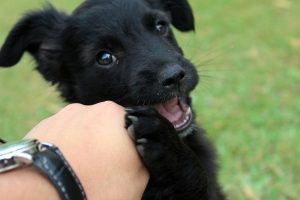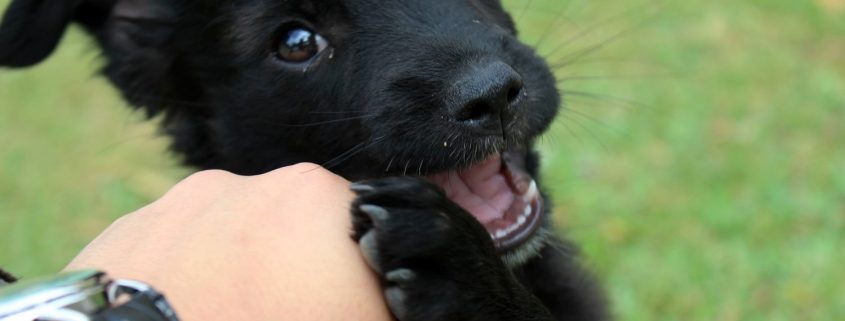Ask Crystal: Bite-y Dog Problems

Dear Crystal,
I have a dog that just turned one, but he’s way too hyper and he will bite my smaller and older dogs’ neck when he gets excited. He doesn’t know how to back off of him when he is obviously not wanting to deal with him trying to play. Please help, when we try to discipline him, he starts barking at us and biting us, we also can’t figure out how to get him to stop biting.
Sincerely,
Ouch that Hurts
Dear Ouch,
Believe me when I can say I can sympathize! I have a one-and-a-half-year-old dog who is challenging to say the least. Adolescence usually starts when a dog is about 5 months and can last until they are a couple of years old. When it starts and ends depends on the size of the dog. This is the most challenging time of a dog’s life. It is the age that the majority of dogs are surrendered to animal shelters. Think of it as equivalent to being a human teenager. They are pushing the limits and don’t have fully developed brains. Have hope as there are things you can do to help his behavior until he gets out of this stage.
Dogs are similar to humans in that this period of their life is about becoming independent which is a big part of the difficult behavior. Dogs in the wild would go off to live on their own soon so they start to prepare for that. Their brains don’t understand that isn’t going to happen in this case.
I say all of this in the hopes that it will help you to be patient when your dog is behaving in a frustrating way. I find that knowing that something Is temporary is also helpful. There isn’t anything wrong with him and it will get better with some time and effort.
Having an adolescent dog with an older dog is often a challenge. It is especially challenging if the older dog isn’t good about standing up for themselves or the younger dog doesn’t listen to his corrections. If he does correct him, be sure to allow him to do that. The best way for a dog to learn his behavior is rude and unwanted is a correction from another dog. A low- level correction may be a turn away, lip lick, closed mouth or whale eye. If that doesn’t seem to be heard they may growl, lift their lip, freeze or stare. Next steps would be an air snap, growl, bark, muzzle punch. The last levels are bites which we hope the dogs never get to and we should try to prevent if at all possible.
Most likely your dog is offering some at least subtle signals and the younger pup is ignoring them. If that is the case or the older dog is not offering corrections, you will need to step in to be the older dog’s advocate. I would recommend having a short leash or just a regular leash on the youngster. When the other dog tells him that he doesn’t want to play, call him away and have him take a short break. It can be as short as 20 seconds. Have the dog do a few behavior cues to help them get back into their thinking brain which will help calm him down. Let him approach again and every time he offers the rude behavior call him away and take a break. He needs to learn play will stop with the undesired behavior.
We should provide daily structured exercise, mental stimulation in the form of enrichment and training in order to tire these dogs out. They have more energy than they will ever have and not having their needs met is one of the main reasons that dogs have behavior problems.
One of my first suggestions for any dog is feeding from enrichment toys. It is one of the easiest changes you can make. Studies show that dogs prefer to work for their food. Just think about how dogs eat in the wild. There aren’t bowls of food hanging out in the woods. Dogs spend most of their time scavenging and hunting for food and then they sleep. We can simulate this behavior by scatter food in the grass, stuffing bones with food, putting food in boxes or using commercial feeding toys. This is the only way my dogs eat. Feeding them this way buys me an hour in the morning and at night so that they are quiet and calm. Licking is soothing, and chewing is stress relieving, so I love using stuffed bones or Kongs.
My favorite way to exercise dogs is through sniffy walks. For this type of walk, you use a long line like a 15-foot leash. This is not a Flexi-Leash. The leash needs to feel loose to simulate being off leash. Walk the dog in a quiet place like a field at a school. There should not be a lot of activity to overstimulate the dog. Let the dog decide where to walk and let them sniff as long as they would like. Sniffing lowers a dog’s pulse, so it is a calming activity. Dogs on a long line sniff 80% more than dogs on a short leash. Sniffing also is mentally stimulating. These walks tire the dog out and calm them down a million times better than a short leash walk can.
Adding structured play into your dog’s exercise routine will provide an additional level of exercise with minimal effort on your part. Structured play means incorporating training into play sessions. When combining play and training, we are using the strong reinforcement of play with impulse control training. Impulse control helps your dog learn to wait patiently for the things they want. It also helps teach them to stay calm when exciting things happen. Some examples of structured play are two toy fetch, tug with rules, and flirt pole with rules.
Training sessions are a wonderful way to tire a dog out. It will also teach them how to live in our world and have a way to communicate with humans. An adolescent dog can benefit from playing the Name Game to teach a solid recall and to interrupt unwanted behaviors. Wait is a great self-control exercise and keeps the dog safe from running out doors. Stay is another great impulse control exercise that is very useful when you are cooking or eating and want the dog out of the way. SMART X50 is a training technique where you take out 50 treats a day and reinforce any offered behaviors you like. Training just happens while you are living your life and it doesn’t have to be long. 15 minutes a day will go a long way towards training your dog.
There is also a balance between being under and over stimulated. A good example is a dog that goes to dog daycare every day and when she comes home, she is ready to party. Do we really think this dog has so much energy that after playing all day she still needs more? What Is more likely is she is receiving too much stimulation and can’t calm herself down. Like all things in life, we have to find the right balance for the individual. Also, we don’t want to turn our dogs into athletes with too much exercise.
To incorporate rest periods, I recommend a couple of techniques. One is to crate train your dog and have them take naps a couple of times throughout the day. When I first got my cattle dog, she would never stop moving. I started to enforce nap times and it was a blessing for both of us to have her take a couple of short naps. I also am obsessed with relax on a mat training. This training technique teaches a dog to go lay down on a mat when they don’t know what to do with themselves or feel anxious. I have seen shelter dogs that cannot stop moving finally relax after a couple of training sessions with this technique.
There is a bit of experimentation to figuring out exactly how much of everything your dog needs to be fulfilled. A good routine for my dogs is enrichment feeding, sniffy walk, a fetch session and a little training throughout the day. I have very high energy dogs so they might need more stimulation than others. As dogs age, they will require a lot less exercise and work. Tweak the routine as needed until your dog seems happy and tired. Hopefully, that will stop him from pestering the other dog and bring his intensity down.
The “biting” I assume you mean mouthy behavior rather than aggression. If you are referring to aggressive bites which are bites meant to threaten, then you need to have a trainer come out and consult with you. If it’s more of an over arousal mouthing, all of the above tips will help a lot.
If you notice any triggers for the mouthy behavior, try to avoid those. I assume if he starts the behavior when you are punishing him then he doesn’t like what you are doing, and I would suggest that you stop using that method. Punishment as a training method isn’t terribly effective and can cause dogs to behave aggressively. I don’t know what you are punishing him for exactly, but I usually suggest calling the dog away from the thing that they are doing that you don’t like and redirecting them onto something more appropriate.
Normal mouthy behavior is usually an attempt to play or get attention. In those cases, we want to first try to redirect the dog onto an appropriate play toy. If that doesn’t work, I will leave the room until the dog can calm down. When they are in that state of mind, they are in their emotional brain and they aren’t able to think or learn. Any yelling or physical punishment is just adding fuel to the fire. Calmly leaving the area and giving them a moment is the safest and best practice in that situation.
I hope if you are able to implement even some of these tips that you will see an improvement in your dog’s behavior. He will still be a challenge until he grows out of this phase but it should help to make life a bit more tolerable while he is growing up. Good luck!
Until next time,
Crystal
Submit your own pet behavior question for Crystal here:







 photo created by wirestock - www.freepik.com
photo created by wirestock - www.freepik.com